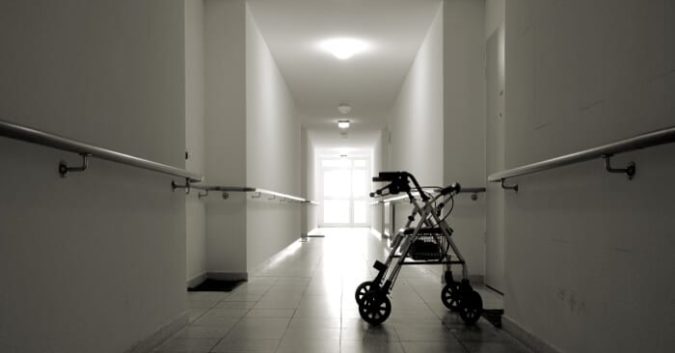More than two-thirds of the 46,000 seniors receiving care at Department of Veterans Affairs (VA) nursing homes suffer serious health problems. They’re more likely to have bedsores or pain, for example, than residents of private nursing homes.
You might assume, as the VA always argued, that veterans face higher rates of sickness having returned from service. Indeed, the VA positions itself as providing more specialized care than its private-business counterparts.
But internal documents reveal reasons much more sinister.
Last week, the media exploded with reports that the VA hid critical data about its nursing homes from the public – data that suggest the facilities’ residents are suffering from neglect and misuse of drugs. USA TODAY and The Boston Globe, having obtained an internal analysis about the nation’s 133 VA nursing homes, are working on making it public.
VA Nursing Home Ratings Hidden from the Public
As far back as 2011, VA nursing homes used at least 2 dozen factors to measure their healthcare quality. None of this information was released or used to improve healthcare quality, though – even after a 2011 review found that 80 percent of VA nursing homes mismanaged residents’ medications.
The agency launched a new tracking system 5 years later, similar to that used by private facilities. It now assigns star ratings to 11 quality indicators, including rates of infection, falls, bedsores, and ability to perform basic daily activities: all indicators of larger problems like understaffing or neglect. Again, no data have ever been released.
Until this month. Blaming the Obama administration for not going public earlier, the VA finally caved under media pressure to expose the last 2 years’ worth of star ratings.
USA TODAY’s initial analysis shows VA nursing homes scored below the private sector average on 8 of 11 indicators – nearly half (60) of them scoring 1 out of 5 stars. By the end of 2017, that increased to 9 of 11 indicators. And though the VA scored only slightly worse than private nursing homes on some of these factors, they scored dramatically worse on others.
For example, VA residents are 5 times more likely to report problems with pain than private residents. They’re also about twice as likely to receive antipsychotic drugs, which the Food and Drug Administration (FDA) recently found to increase seniors’ risk of death.
Additional inspection reports obtained by the Globe describe veterans lying in their own urine and feces and struggling to eat with staffers nearby, among other major deficiencies. One resident of a nursing home in Bedford, Massachusetts died under “supervision” of an aide who was playing video games at the time of death.
As if inspection findings weren’t enough, there may be more to the story. The VA is yet to release long-term care reports and underlying information on what its star ratings mean. VA officials maintain that it’s “highly misleading” to compare its nursing homes with private ones as veterans’ health conditions are “more challenging,” and described the media’s findings as “fake news.” As to when it will release more data, the agency made no comment.
Could Legislation Help Uncover the True Extent of the Problem?
In an investigative report, experts told USA TODAY they believe VA nursing home ratings were purposely withheld to hide substandard care. They now urge the agency to release all data not only immediately, but on an ongoing basis.
Senator Doug Jones (D-AL) kicked off the response by introducing legislation that would force the VA to release all nursing home quality ratings at least once a year. Without it, Jones says, “there’s little we can do to fix quality problems.”
Unfortunately, this lack of transparency is an issue we see in private nursing homes, too.
The private sector may have scored higher than the VA on paper, but it’s far from innocent. In fact, 1 of 3 nursing homes has been cited for abuse. Reports of severe physical, emotional, financial, and sexual mistreatment have grown to epidemic levels across the country. And disturbingly, 60 percent of the nation’s nursing homes are owned by for-profit Wall Street investors with more concern for profit than their residents’ safety.
What has left nursing home abuse spiraling out-of-control? Severe underreporting. Evidence suggests we don’t know half of what goes on in our elderly loved ones’ homes, thanks to the industry’s secrecy – making it very difficult to ensure quality care.
If we can’t assume government-run facilities are safe either, where do families turn?
The Repeated Federal Failure to Care for Vulnerable Veterans
Under federal law, private nursing homes are required to disclose information about their operations, resources, and care. The federal government uses this data (plus its own inspection results) to calculate quality measures, which it posts on the Centers for Medicare & Medicaid Services (CMMS) website.
But these regulations don’t apply to the VA. Until now, the agency has operated its nursing homes largely under the radar, and small wonder this aroused suspicion given the VA’s track record.
VA scandals date back to 2014, when a report claimed a third of veterans died waiting for enrollment in benefits programs in a backlog of 800,000 applications. The VA has also drawn criticism for hiding major medical errors in its hospitals, including preventable deaths – as we’ve now seen in its nursing homes.
And by keeping deaths and injuries under wraps, the federal agency has stopped countless families from finding reliable long-term care for their loved ones – making the already heart-wrenching decision to place their welfare in the hands of others all the more difficult.
This information wouldn’t only have been helpful to veterans looking for a peaceful place to live out the rest of their days, after serving our country so bravely. It would have been the least they deserve.
How do VA nursing homes stack up in your area? Use USA TODAY’s records to find out.
